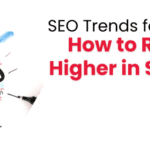
How to Optimize Your E-Commerce Site for Better Conversions through SEO
Optimizing an ecommerce store for conversion is crucial in today’s competitive digital marketplace. Just attracting visitors to your store isn’t enough. The real challenge is turning them into repeat customers. Conversion optimization ensures that every element of your website is designed to encourage users to make a purchase. Conversion rate optimization, or CRO, can help boost your revenue without needing to drive additional traffic to your website.
SEO plays a key role in this process. It doesn’t just improve your visibility on search engines, SEO helps attract the right audience – people who are searching for products you offer.
By aligning your SEO strategies with your audience’s needs and intentions, you don’t just increase traffic but also increase the likelihood of conversion. When done effectively, SEO becomes a powerful tool that bridges the gap between attracting visitors and converting them into customers.
Conduct Keyword Research to Target the Right Audience
Understanding Buyer Intent
Understanding the intent behind your customers’ searches is crucial. Are they looking for information, comparing products, or ready to buy? Targeting keywords that align with high-intent searches can directly boost your conversion rates. For instance, a person searching for “best 4K TVs under $500” is more likely to make a purchase than someone who searches for “What is a 4K resolution TV?”
Tools for Effective Keyword Research
Tools such as Google Keyword Planner, SEMrush, and Ahrefs can help identify keywords that align with your audience’s intent. These tools provide insights into keyword volume, competition, and even suggest related keywords. This is helpful for crafting an effective keyword strategy.
Focusing on Long-Tail Keywords for Higher Conversion Rates
When someone types in “organic cotton baby clothes online,” they’re using a long-tail keyword. These types of keywords are detailed and often indicate higher purchase intent. Even though they have a lower search volume, they tend to convert higher because they attract users who are already further along in the buying process.
Optimize Product Pages for SEO
Importance of Descriptive Product Titles and Meta Descriptions
Your product titles and meta descriptions are often the first thing that users will see in the search results. Clear, keyword-optimized titles and descriptions can boost click-through rates, which is the first step toward conversion.
Writing Engaging and Keyword-Optimized Product Descriptions
Here are some tips for writing engaging and keyword-optimized product descriptions:
- Use clear and descriptive titles: Include key details to make your product easily identifiable and attractive in search results.
- Include relevant keywords naturally: Seamlessly blend relevant keywords into the description to improve SEO without reducing readability.
- Highlight unique selling points: Emphasize features and benefits that make your product stand out.
- Write for your audience: Customize the tone and language to fit your target audience’s preferences.
- Use persuasive language: Incorporate action-oriented phrases to encourage users to make a purchase.
- Include specific details: Provide precise information about size, materials, and functionality to address customer queries.
- Add high-quality images: Complement descriptions with enticing visuals for an enhanced product presentation.
- Optimize for readability: Use bullet points and short paragraphs for easy, quick scanning and understanding.
Use High-Quality Images with Proper Alt Tags
High-quality images play a key role in showcasing your products. They’re important for SEO too. Use descriptive alt tags with relevant keywords. This helps search engines to understand what your image represents. This can improve your visibility in image search results.
Improve Site Structure and Navigation
It’s crucial to have a clean and logical website structure for SEO and user experience. A well-organized site helps search engines crawl and index your pages better. It also makes it easier for users to find what they need. Use a simple, user-friendly navigation menu that categorizes products logically. This allows users to browse the website seamlessly.
Internal linking is another important aspect. Proper internal linking helps with SEO by distributing page authority across your site. It also improves navigation, guiding users to related products and relevant content. This could increase the time users spend on your site and improve their overall experience.
Leverage User-Generated Content: Adding Reviews & Testimonials
User-generated content can have a significant impact on SEO and conversions. Positive reviews build trust and credibility, influencing potential customers’ purchasing decisions. Ask your customers to write reviews. You can send them a follow-up email or offer incentives to encourage more reviews.
Adding review schema markup to your product page will enhance its visibility in search engine results. It will display star ratings and review details directly in search results. This increases product visibility and attracts more visitors organically.
Focus on Mobile Optimization
With an increasing number of consumers shopping from their phones, making your site mobile-friendly is key for SEO and conversions. A responsive website design ensures that your site functions well on any screen size, and quick page loads will help retain users. Here are some tips to optimize your website for a better mobile experience:
- Ensure responsive design: Your website should automatically adjust to various screen sizes.
- Improve mobile page speed: Compress image sizes and minimize code for quicker loading time.
- Optimize navigation: use a touch-friendly and simple menu for effortless navigation.
- Streamline checkout: Reduce steps and simplify form to enhance conversions through mobile devices.
- Test mobile usability: Regularly test your site across multiple devices for consistent user experience.
Use Rich Snippets for Better Visibility
Boost your website’s visibility in search results with rich snippets. By using structured data markup, you can provide search engines with more details about your products, like cost, availability, and reviews. This extra data can make your search engine results page listings stand out in SERPs, attracting more clicks that could increase your conversion rates.
Improve Site Speed and Performance
Site speed is a critical factor for both SEO and user experience. A slow-loading website can lead to higher bounce rates and lower conversions. Use tools like Google PageSpeed Insights and GTmetrix to test your site speed. These tools will also help you identify areas for improvement.
Optimize your site’s performance by compressing images, using browser caching, and minimizing HTTP requests. Monitor and improve your site speed regularly to provide a better user experience and boost your SEO rankings.
Conclusion
Driving better conversions on your ecommerce store needs strategic SEO approach. As the digital marketplace evolves, improving user experience and aligning with search engine best practices is key to your success. Consistently refine your SEO efforts to create a seamless shopping experience that not only attracts visitors but attracts them into loyal customers.










